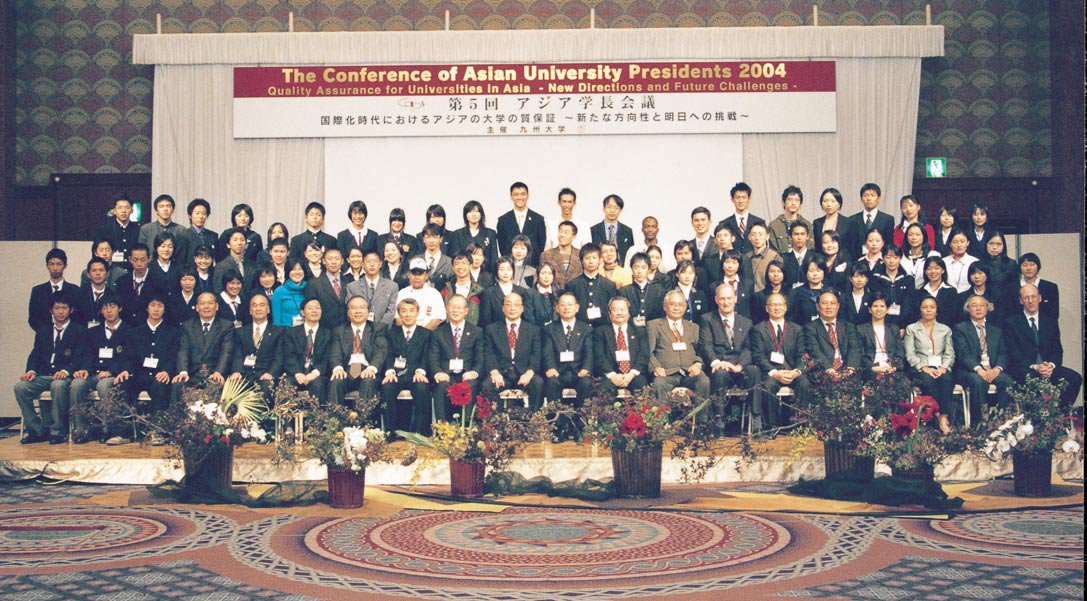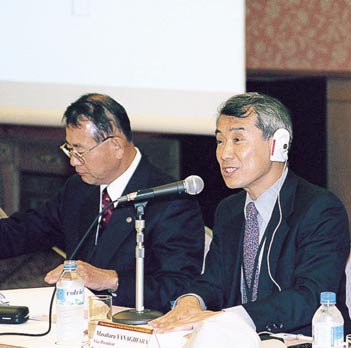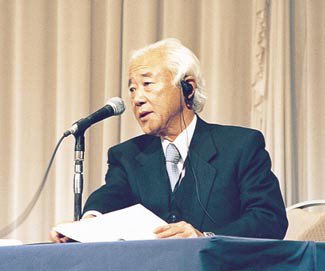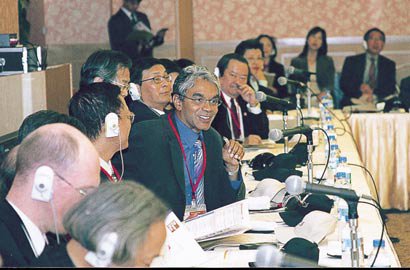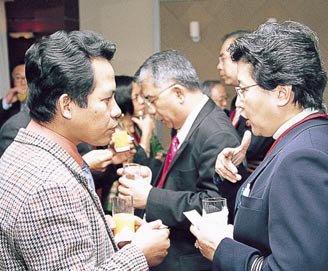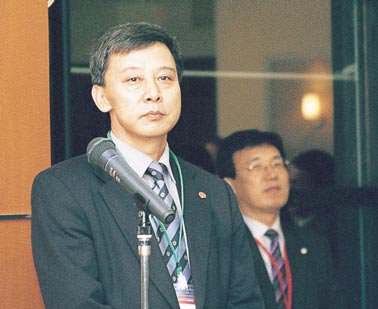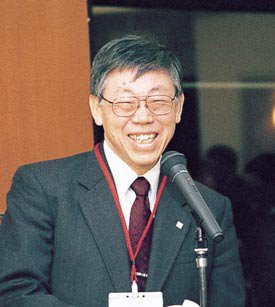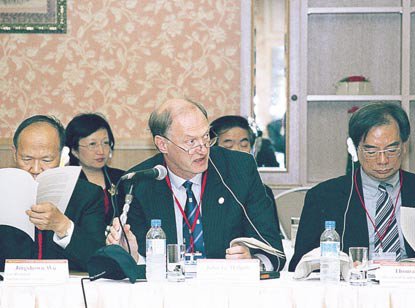
Operrational Ligison committee
Oversight Committee
Vice President for international Affairs, Chair of Steering Committee Kyushu University
The 5th Conference of Asian University Presidents, hosted by Kyushu University, was held on Saturday and Sunday, November 27th and 28th, 2004. The theme of the conference was, gQuality Assurance for Universities in Asia- New Directions and Future Challenges.h Participating in the conference were 26 universities from 10 countries and regions in Asia (East Asia in a broad sense). Participants from Japan included Kyushu University, Waseda University, Ritsumeikan University, and Ritsumeikan Asia Pacific University.
At the opening session on the 27th, President Tisato Kajiyama said, gI am expecting discussions at this conference to be based on mutual respect, and understanding of the commonality Asian universities share, and to lead to further improvement in the quality of all Asian universities.h Akira Ishikawa, the Director General of the Ministry of Education, Culture, Sports, Science and Technologyfs Higher Education Bureau, in his address to the participants voiced his desires for the conference by saying, gIn light of the globalization of higher education, the theme of this conference is a timely one, and I want you all to provide good directions for future initiatives.h
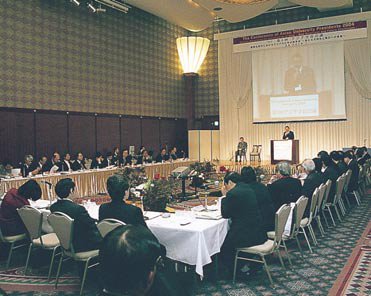 The first result of this conference was the formal adoption of the charter for the Conference of Asian University Presidents. This charterfs provisions, among other things, make it possible for universities to mutually establish branch offices; call for the organization of the Oversight Committee for the management of this conference; establish the Oversight Committeefs secretariat at Kyushu University; call for this conference to be held biennially, in principle; make it possible to hold symposiums on specific topics in years when this conference is not held; and call for the appointment of a contact person at each of the formal members of the conference to facilitate communications. The Conference of Asian University Presidents, therefore, made a fresh start under a new framework, following the provisions of this charter.
The first result of this conference was the formal adoption of the charter for the Conference of Asian University Presidents. This charterfs provisions, among other things, make it possible for universities to mutually establish branch offices; call for the organization of the Oversight Committee for the management of this conference; establish the Oversight Committeefs secretariat at Kyushu University; call for this conference to be held biennially, in principle; make it possible to hold symposiums on specific topics in years when this conference is not held; and call for the appointment of a contact person at each of the formal members of the conference to facilitate communications. The Conference of Asian University Presidents, therefore, made a fresh start under a new framework, following the provisions of this charter.
The members of the Oversight Committee will include seven universities: Pusan National University, Chulalongkorn University, Thammasat University, Mahidol University, National Taiwan University, Kyushu University, and the host of the 6th Conference of Asian University Presidents. Requests to host the 6th Conference of Asian University Presidents to be held in 2006 will be accepted and the selection of the host will be made by the Oversight Committee.
The second result of this conference was a discussion of two topics: adopting a common curriculum and developing the young researcher training programs. It was decided that details of these programs would be addressed in discussions to take place with the key participation of the contact people to be appointed at each university. Also, to promote the work of young researchers, it was determined that the awards system would be established and that an award ceremony will be held at the next conference.
The third result of this conference was the holding of the Asian University Student Meeting and the Asian High School Student Meeting and a dialog among these high school and university students and university presidents, all on the theme of gReflections on the Future of Asia.h Participants included 8 high school and 20 university students from parts of Asia outside of Japan, and 48 high school and 31 university students from Japan. Altogether, 150 people participated in these discussions. The most lively event of the conference appears to have been the dialog among students and university presidents. Penetrating questions, such as gWhat is the significance of studying as a foreign student at an Asian university, rather than a European or American university?h were posed. And the university presidents, not to be outdone, rose to the occasion with witty responses.
During the conference, space was set aside for the display of posters promoting Kyushu Universityfs Asian research activities and the activities of other participating universities, and this area became a place for representatives of the various participating universities to meet and have discussions. At the finalday session themed, gAsia in a Tri-Polar World,h Motoyuki Ono, President of the Japan Society for the Promotion of Science (JSPS), gave a talk outlining the activities of the JSPS. Furthermore, the idea of distributing to participants caps with the gCAPsh logo seems to have been a hit.
The purpose of the Conference of Asian University Presidents is to both foster friendly relationships among university presidents and to have fruitful discussions of concrete themes. This most recent conference can be praised as having fully accomplished both of these purposes. One university president commented that of all the CAPs conferences he had attended, this one featured the most substantial discussions. Another university president said that this conference was the best of those he had attended and upon hearing that, I felt like the fatigue from the nearly one year of conference preparation disappeared immediately. I want to offer my sincere thanks to the many staff members who helped make this conference a success.
|
Successful Conclusion of the 5th Conference of Asian University Presidents
|
Report on the 5th Conference of Asian University Presidents
gDevelopment of Young Researcher Training
Programs amongst Asian Universitiesh
Kazuo OGATA (Institute of Tropical Agriculture)
Hideyuki YAMADA(Faculty of Pharmaceutical Sciences)
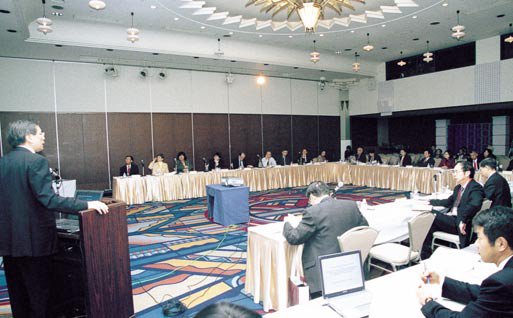 Young researchers are important human resources who will steer research and education in the next generation, and it is not an exaggeration to say that over the mid- to long-term, the quality of universities depends on their activities. The securing of excellent young researchers will determine the future of not only Japanese universities but also universities pursuing reform in other parts of Asia. The Development of Young Researcher Training Programs session was created within this context and for the purpose of improving the quality of young researchers through a partnership of Asian universities.
Young researchers are important human resources who will steer research and education in the next generation, and it is not an exaggeration to say that over the mid- to long-term, the quality of universities depends on their activities. The securing of excellent young researchers will determine the future of not only Japanese universities but also universities pursuing reform in other parts of Asia. The Development of Young Researcher Training Programs session was created within this context and for the purpose of improving the quality of young researchers through a partnership of Asian universities.
This session began at 9:00 AM on the second day of the Conference of Asian University Presidents (CAPS) and featured two hours of fervent debate by representatives of 16 universities (including Kyushu University) from seven countries. After explanations of the background and purpose of the session, the following four people made presentations (titles omitted):
| (1) | Amaret Bhumiratana (Mahidol University, Thailand) "The Example of Mahidol University" |
| (2) | Kenichi Uchino (Professor, Faculty of Engineering, Kyushu University) "Introduction of the Development of Researcher Training Programs in the Field of Engineering" |
| (3) | Tatsuaki Inoue (JICA Kyushu) "JICA and Internship Programs" |
| (4) | Hideyuki Yamada (Professor, Faculty of Pharmaceutical Sciences, Kyushu University) "Possible Financing" |
Following the above four presentations and question and answer sessions, a discussion of gYoung Researcher Training Programsh took place. Professor Amaret Bhumiratana also addressed this in his presentation, but gtraining young researcherh means developing researchers able to work on their own. It was suggested that, to promote that kind of activity and create high-quality research, CAPS should establish the awards system.h The value of a prize sponsored by CAPS is the potential for it to become an internationally recognized honor for the recipient and its usefulness in enhancing awareness of CAPS itself. Moving forward, it would appear that concrete work regarding, for example, the establishment of fields and an evaluation system will be necessary.
There is also strong desire for the holding of short-term training courses. Roughly speaking, there is the approach of establishing a foundation and working from the bottom up and, alternatively, the approach of gathering excellent young researchers and focusing training on cutting-edge fields. There is also the option of forming consortiums by field and having each university work in a field in which it excels, as Professor Uchino described in his presentation. There are many matters, such as fields, content, locations, and timing, for which arrangements will be needed, but everyone agreed on the need for basic surveys and arrangements to address necessities for the actual performance of training courses and the matter of what courses will be offered.
Report on the 5th Conference of Asian University Presidents
Collaboration amongst Asian Universities to Develop Joint Curricula and Teaching Programs
Director / Professor
Kyushu University Asia Research Organization
In this session, present situation of and fundamental issues related to future development of joint curricula and teaching programs were presented and discussed. According to a survey carried out prior to the conference a total of 47 joint curricula/teaching programs are already in operated at the following 7 member universities of the conference: The University of Science and Technology of China, The Chinese University of Hong Kong, Mahidol University, Chulalongkon University, Hanoi Agricultural University, University of Malaya and National University of Singapore. Among them, 17 programs are with European partners, 17 with American/Canadian partners, 8 with Australian/New Zealand partners and 47 with Asian partners. (Numbers are not exclusive.) Amongst them, some are eOffshoref type, which means that a superior partnersf program is offered and operated at an eoffshoref universityfs campus. In other words, all the teaching, including teaching materials, are prepared and provided by the superior partner, while the eoffshoref university provides the facilities, including classrooms and students. Others are more mutually operated: every partner involved equally and uniquely contributes to build the program, therefore teaching is shared as well as venue for teaching / training. For more details on each program, please visit the following web site:
http://www.isc.kyushu-u.ac.jp/intlweb/html/opcia/asiaconf/hp/HP/JpointC.htm
As for eQuality Assurancef needed when developing internationally operated joint curricula / teaching programs, all the participants in the session agreed that the following four areas should be looked carefully: 1) how to check and secure the content of teaching / training offered, 2) how to assess and grade the outcome of participation, 3) how to implement credits transfer system and 4) how to secure good enough accommodations and provide efficient orientations for incoming participants. To achieve the ends mentioned here, existing faculty / students exchange ties and UCTS (UMAP Credit Transfer System) are recognized useful enough to form the foundation for future development of international joint programs. It was also pointed out that founding is needed, perhaps, but more likely willingness develop joint curricula and teaching programs for the sake of academic co-operation with a win-win situation in Asia is more urgently needed. The session was concluded with a suggestion that the conference body appoint a contact person for each member university in order to co-operate and develop future joint curricula and teaching programs.
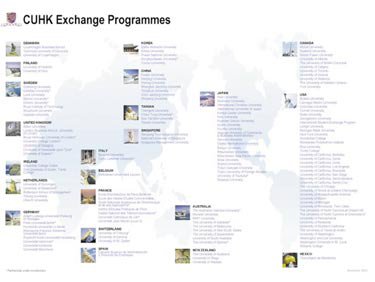

Charter of the Conference of Asian University Presidents
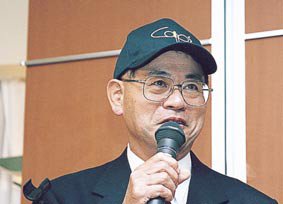 With the express intent of formalizing dialogue amongst Asian universities on the significance of Asia in a globalizing world, of establishing a cooperative network of universities that can contribute to the development of the Asian region in the 21st Century, and of affirming the importance of Asia to Kyushu University, the First Conference of Asian University Presidents was inaugurated and hosted by Kyushu University in December 2000. The Conference was hosted by Kyushu University in 2001, by Pusan National University, in 2002, and by Chulalongkorn University with the cooperation of Mahidol University and Thammasat University in 2003.
With the express intent of formalizing dialogue amongst Asian universities on the significance of Asia in a globalizing world, of establishing a cooperative network of universities that can contribute to the development of the Asian region in the 21st Century, and of affirming the importance of Asia to Kyushu University, the First Conference of Asian University Presidents was inaugurated and hosted by Kyushu University in December 2000. The Conference was hosted by Kyushu University in 2001, by Pusan National University, in 2002, and by Chulalongkorn University with the cooperation of Mahidol University and Thammasat University in 2003.
Through the activities of the Conference, mutual trust and respect among participating institutions have been enhanced. The number of participating universities has increased every year and for the 2004 Conference twenty-six institutions will be represented. The growth in the number of participants indicates the importance that is attached to developing relationships among universities of the region. With the purpose of further developing the Conference and activating joint research and student exchange programs among Asian Universities, the Charter of the Conference of Asian University Presidents is hereby established.
(Objectives of the Conference)
Article 1. The Conference of Asian University Presidents was inaugurated in 2000, having ascribed central importance to contributing to the sustainable development of the Asian region. With the objective of establishing new collaborative relations and forming a network among Asian universities, the Conference facilitates dialogue between Asian universities on matters pertaining to education, research university-industry partnership, university management, and increasing interchanges between staff and students among participating universities, as well as other themes agreed upon by participants.
(Action Programs)
Article 2. With a view to enhancing educational and research exchanges, the Conference will discuss specific plans such as joint research activities; student exchange programs and credit transfer schemes; training programs for researchers; and the development of joint courses.
(Participating Universities)
Article 3. 1. The full members in the Conference will be determined by the Oversight Committee, which is defined in Article 6.
2. The associate members can also participate in the Conference even if they are not from the Asian region if they are invited by the Oversight Committee.
(Branch Office)
Article 4. The participating universities in the Conference may agree bilaterally to establish Branch Offices. Branch Offices shall have the following purposes:
(1) constructing a database of the research activities of their university in order to promote joint research projects and at the same time exposing the research achievements of Asia to the world;
(2) providing a focal point for the exchange of researchers and students and also providing effective assistance to visiting researchers and students;
(3) and, to publicize the partner university and to help recruit students and researchers.
(Expenses)
Article 5. With regard to the expenses of hosting the Conference, a MOU is determined separately.
(Oversight Committee)
Article 6.
1. For the purpose of coordinating the Conference management, an Oversight Committee of the Conference of Asian University Presidents (hereinafter referred to as the Oversight Committee) will be established. The secretariat of the Oversight Committee will be set up at Kyushu University. The term of the secretariat is four years and is renewable.
2. With regard to the universities that constitute the Oversight Committee, a MOU is determined separately.
(Hosting the Conference)
Article 7. In principle, the Conference is to be held every two years. In a year when the Conference is not being held, a symposium on a specific field may be convened.
(Contact Person)
Article 8. For the purpose of facilitating communication, full members shall nominate one contact person. In principle, the contact persons shall meet at the symposium on a specific field in a year when the Conference is not being held.
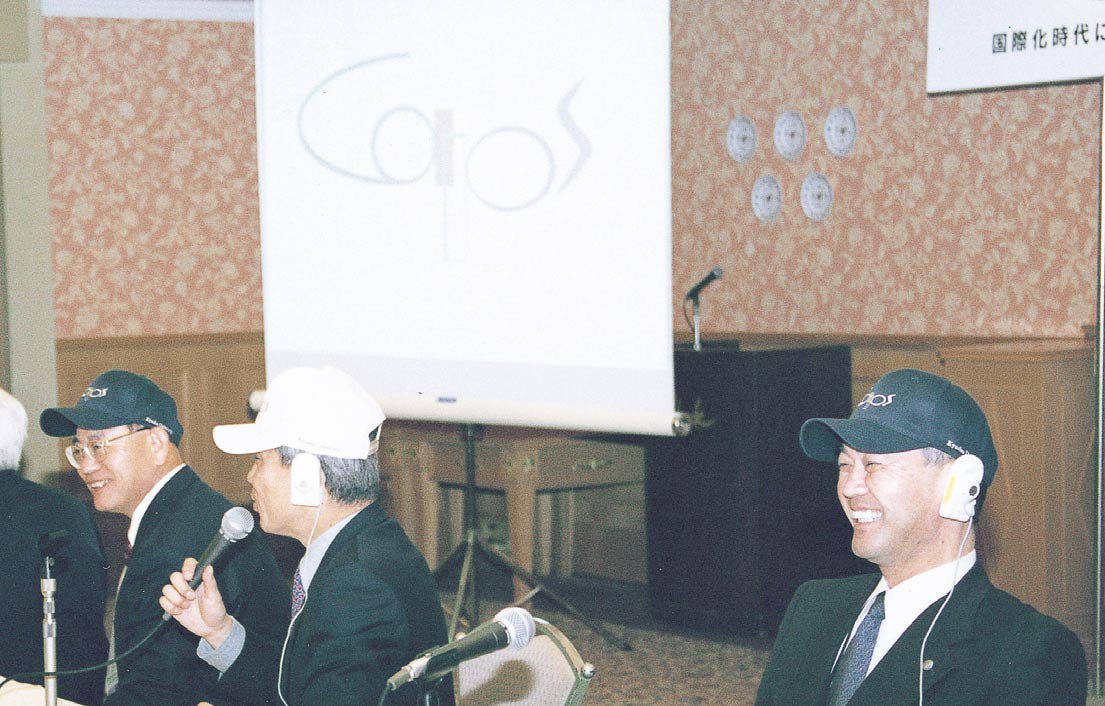 |
| President Kajiyama (left), Vice President Yanagihara (center) and Shibata (right), putting on original caps for Conference of Asian University Presidents |
Memorandum of Understanding (MOU) on the Funding of the Conference of Asian University Presidents
This MOU sets out the basis upon which the parties have agreed to collaborate in the matter of the Funding of the Conference of Asian University Presidents.
According to Article 5 of the Charter of the Conference of Asian University Presidents, the funding of the Conference of Asian University Presidents is to be settled as follows:
1. In principle, the host university shall bear the expenses of managing the Conference.
2. As for the travel and accommodation expenses for the full and associate members, the host university can adopt any of the following:
(1) The host university bears all expenses;
(2) The host university limits to one person whose expenses are born by the host university;
(3) The full and associate members bear their own expenses;
(4) The full and associate members bear the travel costs and the host university bears the accommodation expenses; or
(5) The Oversight Committee divides the full and associate members into groups and the host university bears all or a part of the expenses according to the groups.
Memorandum of Understanding (MOU) on the Oversight Committee of the Conference of Asian University Presidents
This MOU sets out the basis upon which the parties have agreed to collaborate in the matter of the Oversight Committee of the Conference of Asian University Presidents.
According to Article 6 of the Charter of the Conference of Asian University Presidents, the Oversight Committee of the Conference of Asian University Presidents (hereinafter referred to as the Oversight Committee) is to be settled as follows:
1. The Oversight Committee shall discuss the theme of the Conference, associate members, and other related matters pertaining to the Conference. In addition, the Oversight Committee shall be responsible for the organization of the biennial symposium.
2. The Conference shall at its biennial meeting appoint an Oversight Committee.
3. All full members of the Conference shall be eligible for nomination to the Oversight Committee. The Oversight Committee will be limited to not more than nine members.
